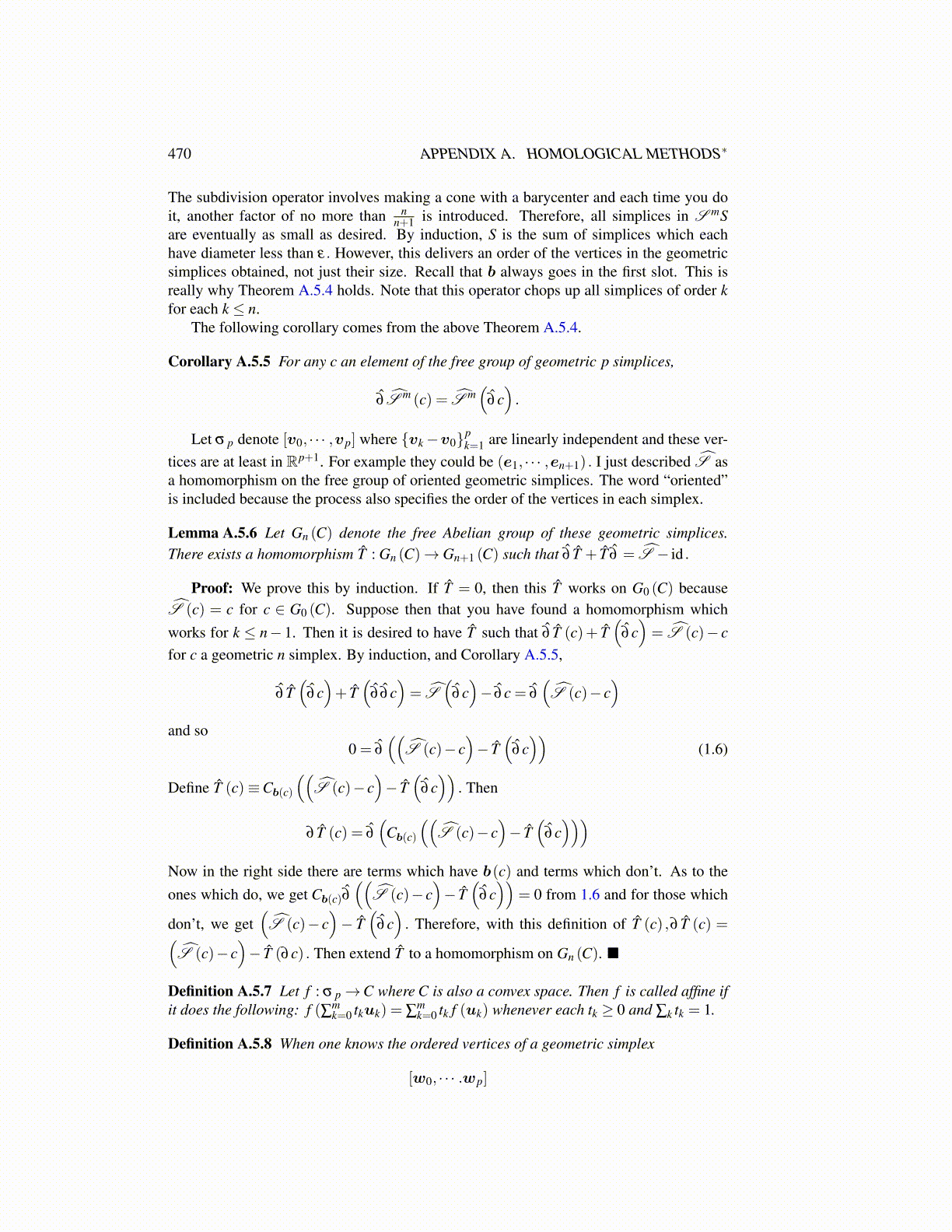
470 APPENDIX A. HOMOLOGICAL METHODS∗
The subdivision operator involves making a cone with a barycenter and each time you doit, another factor of no more than n
n+1 is introduced. Therefore, all simplices in S mSare eventually as small as desired. By induction, S is the sum of simplices which eachhave diameter less than ε. However, this delivers an order of the vertices in the geometricsimplices obtained, not just their size. Recall that b always goes in the first slot. This isreally why Theorem A.5.4 holds. Note that this operator chops up all simplices of order kfor each k ≤ n.
The following corollary comes from the above Theorem A.5.4.
Corollary A.5.5 For any c an element of the free group of geometric p simplices,
∂̂Ŝ m (c) = Ŝ m(
∂̂c).
Let σ p denote [v0, · · · ,vp] where {vk−v0}pk=1 are linearly independent and these ver-
tices are at least in Rp+1. For example they could be (e1, · · · ,en+1) . I just described Ŝ asa homomorphism on the free group of oriented geometric simplices. The word “oriented”is included because the process also specifies the order of the vertices in each simplex.
Lemma A.5.6 Let Gn (C) denote the free Abelian group of these geometric simplices.There exists a homomorphism T̂ : Gn (C)→ Gn+1 (C) such that ∂̂ T̂ + T̂ ∂̂ = Ŝ − id .
Proof: We prove this by induction. If T̂ = 0, then this T̂ works on G0 (C) becauseŜ (c) = c for c ∈ G0 (C). Suppose then that you have found a homomorphism whichworks for k ≤ n− 1. Then it is desired to have T̂ such that ∂̂ T̂ (c)+ T̂
(∂̂c)= Ŝ (c)− c
for c a geometric n simplex. By induction, and Corollary A.5.5,
∂̂ T̂(
∂̂c)+ T̂
(∂̂ ∂̂c
)= Ŝ
(∂̂c)− ∂̂c = ∂̂
(Ŝ (c)− c
)and so
0 = ∂̂
((Ŝ (c)− c
)− T̂
(∂̂c))
(1.6)
Define T̂ (c)≡Cb(c)
((Ŝ (c)− c
)− T̂
(∂̂c))
. Then
∂ T̂ (c) = ∂̂
(Cb(c)
((Ŝ (c)− c
)− T̂
(∂̂c)))
Now in the right side there are terms which have b(c) and terms which don’t. As to theones which do, we get Cb(c)∂̂
((Ŝ (c)− c
)− T̂
(∂̂c))
= 0 from 1.6 and for those which
don’t, we get(Ŝ (c)− c
)− T̂
(∂̂c). Therefore, with this definition of T̂ (c) ,∂ T̂ (c) =(
Ŝ (c)− c)− T̂ (∂c) . Then extend T̂ to a homomorphism on Gn (C). ■
Definition A.5.7 Let f : σ p→C where C is also a convex space. Then f is called affine ifit does the following: f (∑m
k=0 tkuk) = ∑mk=0 tk f (uk) whenever each tk ≥ 0 and ∑k tk = 1.
Definition A.5.8 When one knows the ordered vertices of a geometric simplex
[w0, · · · .wp]